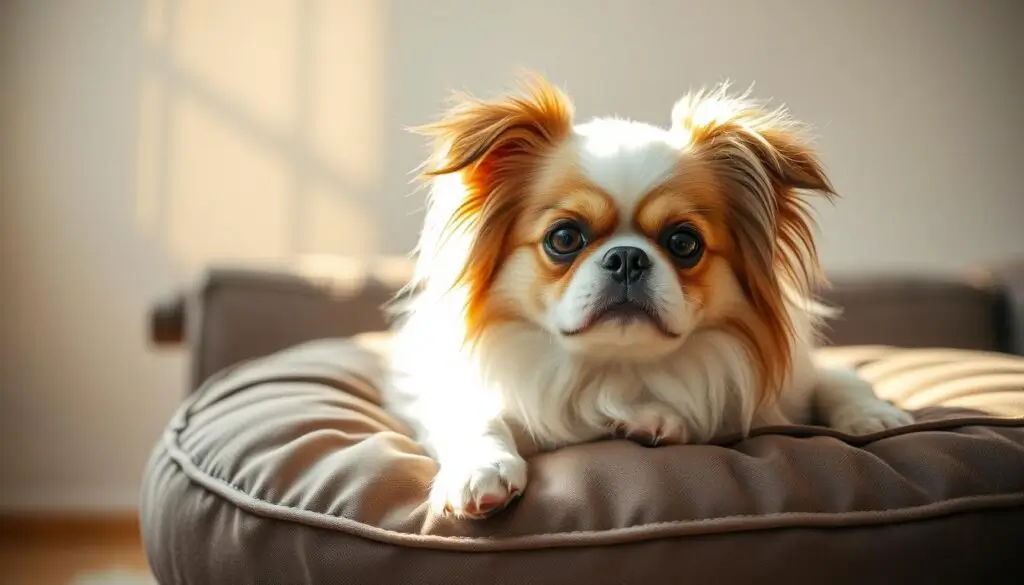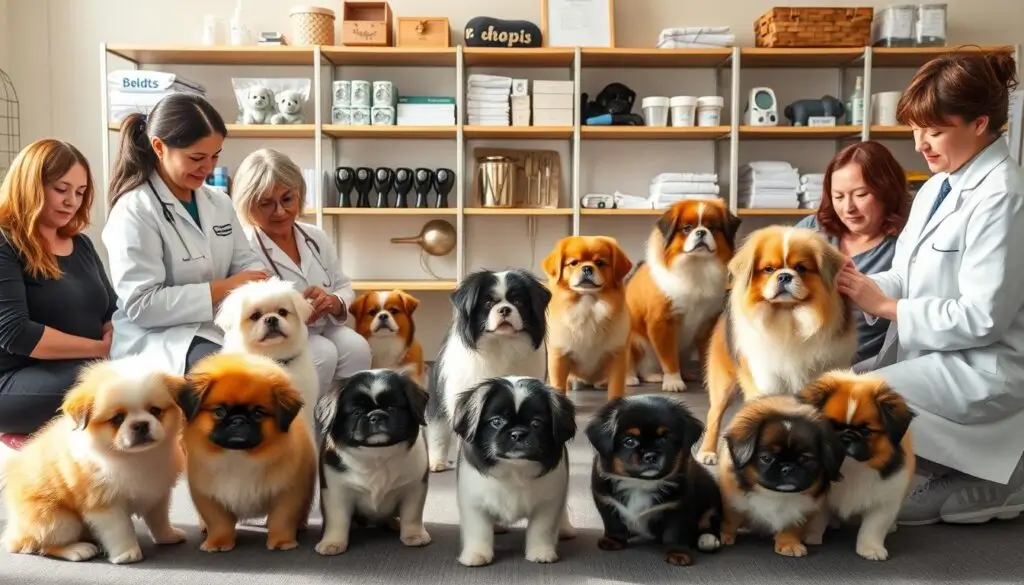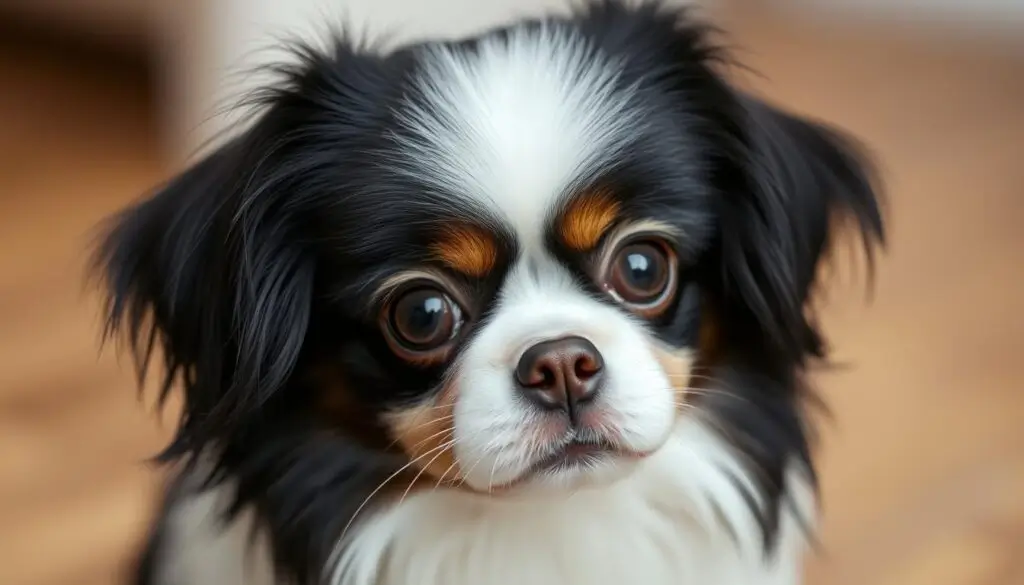The Japanese Chin: A Unique and Affectionate Companion
Imagine coming home to a tiny, regal face looking up at you. Japanese Chins are small dogs, weighing 4 to 9 pounds. They stand 8 to 11 inches tall and have a long history as royal companions.
These dogs are known for their dignified posture and curious nature. But they are also warm and independent. They form strong bonds with their families and keep a quiet pride.
Japanese Chins have beautiful coats in black and white, red and white, or tri-color. They are easy to care for and fit well in modern homes. Their playful yet calm nature makes them perfect for those who want a loving companion.
However, their delicate beauty requires careful attention. Their flat faces need special care to avoid breathing problems. And their small size means they should be fed carefully to prevent obesity. But for those willing to care for them, Japanese Chins offer a deep and loyal friendship.
Table of Contents
Key Takeaways
- A Japanese Chin’s small size (4–9 lbs) and elegant Toy Group classification make them ideal for apartment living.
- Historically cherished by royalty, their cat-like behaviors and affectionate bonds with family highlight their unique temperament.
- Color variations like black and white or tri-color coats add to their visual appeal, with grooming needs suited to weekly brushing.
- Health focus areas include dental care, respiratory monitoring, and genetic conditions like brachycephalic syndrome.
- With origins tracing to ancient palaces, their history intertwines with breeds like the Pekingese, reflecting their storied legacy.
History and Origin of the Japanese Chin
The Japanese Chin’s journey from ancient Asia to worldwide fame took thousands of years. They were first celebrated in Japan but originated in China. There, small dogs were bred over a thousand years ago. They became symbols of prestige in Japan, known for their aristocratic nature.
Ancient Beginnings in Asia
In China, these dogs appeared as early as the 4th century. They evolved alongside the Pekingese and Shih Tzu. Their small size made them perfect for carrying in kimono sleeves or baskets.
By the 6th century, they reached Japan. There, they were refined into the breed we know today. Their arrival began a centuries-long royal bond.
Royal Connections in Japanese History
In Japan, Japanese Chins were the exclusive pets of emperors and samurai families. They were celebrated in woodblock prints and poetry, representing loyalty and elegance. Emperors even gave them to foreign leaders, making them cultural ambassadors.
They lived in luxury, with silk cushions and private rooms. Their lifestyles matched their owners’, showing their high status.
Introduction to the Western World
Westerners first learned about them in 1854 when Commodore Matthew Perry brought a pair to the U.S. Queen Victoria received a Japanese Chin in 1860, sparking interest in Europe. The American Kennel Club recognized them as the “Japanese Spaniel” in 1888.
In 1977, their name changed back to “Japanese Chin” to honor their heritage. Today, their history is seen in their dignified behavior and cultural stories.
Physical Characteristics That Make Japanese Chins Distinctive
Japanese Chin puppies grow into elegant dogs. They weigh 4–9 pounds and stand 8–11 inches tall. Their small size hides a strong build.
Their large, round eyes are the standout feature. They have silky fur and V-shaped ears that fall against their cheeks. The breed’s short muzzle adds to their charm but needs care for breathing.
Coat colors include black and white, red and white, or tricolor patterns. Their long, straight fur needs weekly brushing to avoid matting. By six months, their coats fully develop, showing feathered ears and leg plumes.
Their tails also have curled fur, enhancing their refined look.
| Feature | Description |
|---|---|
| Eye Shape | Large, dark, and wide-set, giving an alert expression |
| Coat Type | Silky, straight fur with feathering on ears, legs, and tail |
| Body Structure | Solid yet compact, with a square-proportioned body |
| Ear Shape | V-shaped, lying close to the head |
Start grooming habits early with puppies. Their short muzzle makes them more prone to breathing issues in warm weather. Regular dental care is also key, as small breed dental disease affects 80% of dogs by age two. These traits make the Japanese Chin’s appearance unique and aristocratic.
The Charming Temperament of Japanese Chins
The Japanese Chin has a calm and curious nature. They love being around people and form strong bonds. Their history as royal pets shows in their dignified yet loving behavior. They are perfect for those who want a gentle and easy-going pet.
“They observe the world with a cat-like curiosity but return to their owners for warmth and affection,” says the American Kennel Club, noting their blend of independence and devotion.
Personality Traits and Typical Behavior
- Calm and observant, often perching on high surfaces like furniture
- Clever yet selective learners—respond best to positive reinforcement
- Reserved with strangers but deeply loyal to their family unit
Family Interaction Style
Japanese Chins love to join in family fun but prefer calm settings. They have a medium energy level, making them great for apartment living. They are very loving but need to be watched around little kids. People often say they are:
- Highly affectionate with trusted family members
- Low-barking, making them discreet housemates
- Enjoyment of gentle play sessions and cozy naps
Pet Compatibility Insights
Japanese Chins get along well with:
- Cats (their cat-like curiosity aids mutual understanding)
- Other dogs if size differences are respected
- Require gradual introductions to avoid standoffishness
Early socialization helps them feel more comfortable around new animals. Their energy levels match well with other pets.
These qualities make Japanese Chins great pets for those who want a thoughtful and elegant friend. They don’t need a lot of exercise.
Essential Japanese Chin Care Guidelines
Proper japanese chin care is key for these elegant dogs to live well. They are small, weighing 7–11 pounds and standing 8–11 inches tall. This size needs special care to keep them healthy and long-lived.
Daily Care Requirements
Regular care protects the japanese chin’s delicate features. Brush their medium-length coat weekly to manage shedding. Clean their facial folds and eyes daily to stop infections. Also, visit the vet yearly to check for common problems like breathing or eye issues.
- Brush teeth 2–3 times weekly to reduce tartar buildup.
- Trim nails every 2–3 weeks to avoid overgrowth.
- Use hypoallergenic wipes for facial hygiene.
Exercise Needs and Limitations
Japanese Chins need 30 minutes of gentle exercise daily. Short walks, indoor play, or puzzle toys are good. But, avoid heat and extreme temperatures because of their flat face. Swimming should be supervised.
Nutrition and Feeding Recommendations
A balanced diet is crucial for their 10–12 year lifespan. Feed high-quality kibble twice a day, avoiding overfeeding to prevent obesity. Add supplements like ProDog Muscle+ for protein or ProDog Digest for gut health. Treats should not make up more than 10% of their diet.
- Switch to senior formulas after 8 years.
- Avoid table scraps and opt for limited-ingredient diets if allergies arise.
By following these guidelines, owners can keep their japanese chin healthy and active for years.
Japanese Chin Grooming: Maintaining Their Elegant Coat
Japanese Chin grooming is crucial for their silky coat and health. Their long, straight fur needs regular care to avoid tangles. Japanese chin care routines keep them comfortable and clean.
- Brushing Basics: Use a slicker brush or pin brush weekly to remove loose hair and distribute natural oils. Focus on areas like the ears and tail where mats form easily.
- Bathing Best Practices: Bathe every 4–6 weeks with a hypoallergenic shampoo. Rinse thoroughly to avoid residue buildup in their long fur.
- Eye and Ear Care: Wipe eyes daily with a damp cloth to reduce tear staining. Clean ears weekly with a vet-approved solution to prevent infections.
- Nail and Dental Care: Trim nails every 3–4 weeks to prevent overgrowth. Brush teeth daily with dog-safe toothpaste to combat dental issues common in small breeds.
In spring, brush them twice a week to handle shedding. For show dogs, professional grooming every 6–8 weeks is beneficial. Always praise them during grooming to make it a positive experience. Regular grooming keeps their coat healthy and their comfort level high.
Common Health Issues in Japanese Chins
Japanese Chins need careful care to live a long life. These small dogs (8–11 inches, under 12 lbs) face certain health risks. Regular vet visits are key to catch problems early.

They often get patellar luxation (kneecap issues) and entropion (eyelid problems). Dental disease hits 80% by age two, shortening their life if not treated. Older dogs may face heart valve issues, while hip and elbow problems can lead to arthritis.
Spinal issues like hemivertebrae can harm nerves. Early checks are needed. Their brachycephalic skull can cause breathing troubles. Signs include hard breathing or getting too hot.
Annual vet visits are crucial. They should include heart checks and dental cleanings. Here are some key health risks:
| Health Issue | Symptoms | Action |
|---|---|---|
| Brachycephalic syndrome | Noisy breathing, heat intolerance | Avoid extreme temperatures |
| Heart disease | Coughing, fatigue | Yearly echocardiograms |
| Eye disorders | Eye redness, cloudiness | Biannual ophthalmic exams |
| Patellar luxation | Lameness, limping | Weight management |
Preventative steps include:
- Yearly blood and urine tests for liver/kidney function
- Dental cleanings starting at 1–2 years old
- Low-impact exercise to protect joints
- Genetic testing before breeding
Japanese Chin owners must act early. Regular vet visits and knowing breed risks can help them live 10–12 years. With proactive care, these loving dogs can overcome their genetic challenges.
Training Your Japanese Chin: Tips and Techniques
Training a Japanese Chin needs patience and positive feedback. They are sensitive and do best with gentle training. Start with simple commands like sit and stay, using treats to help them learn.
Being consistent is crucial. This helps shape their behavior. They are smart but can be stubborn.
Effective Training Methods
Begin with short, regular training sessions. This matches their short attention span. Use a leash and collar to guide them during training.
Positive feedback like praise and treats encourages them to learn. For commands like “stand,” start with short holds and gradually increase the time. Daily practice, even for just a few minutes, reinforces what they’ve learned.
Addressing Behavioral Challenges
- Stubbornness: Use calm repetition and rewards to redirect their behavior. Avoid harsh corrections, as they can make them more resistant.
- Excessive Barking: Find out what triggers their barking and use commands like “quiet” with treats to stop it.
- Separation Anxiety: Start by leaving them alone for short periods with safe toys. Consistent routines help them feel secure.
Socialization Importance and Techniques
Introduce them to people and places early to prevent fear. Start in calm environments and use treats to make it positive. For adult dogs, introduce them to parks or training classes slowly.
Early socialization is key. It helps them grow into well-adjusted pets.
Living With a Japanese Chin: Home Environment Considerations
Japanese Chins fit well in many homes, from apartments to houses with proper care. They are small, standing 8–11 inches tall and weighing 4–9 pounds. This size makes them perfect for smaller spaces, but safety and comfort are key. Their curious nature means they need safe places to play without getting into trouble.
- Install baby gates to block stairs and hazardous zones.
- Remove small objects to avoid swallowing risks.
- Use enclosed fencing for outdoor time.
Keeping them cool is also crucial. Their body shape makes them sensitive to heat. Make sure their living area is not too hot. In summer, air conditioning is a must.
Make their living space cozy with soft bedding and places to climb. They love being up high, like on windowsills or cat trees. Change their toys often to keep their minds active. Also, give them a quiet place to rest when the house is busy.
As they get older (they live 10–14 years), you’ll need to make some changes. Add ramps for stairs and soft mats for their joints. Also, limit their access to stairs. Regular vet visits are important to catch any health issues early.
Japanese Chin care is about finding the right balance. Give them a safe, fun place to live, and they’ll be happy to be part of your family.
How to Find Reputable Japanese Chin Breeders
When looking for japanese chin breeders, choose those who care about the breed’s health. Look for kennels with a good history, like Omikudzi. They’ve bred champions since 2000, including award-winning dogs.
Reputable breeders like Griffon-Land and Stepovyj Viter follow FCI standards. This means they focus on healthy, well-socialized puppies.

Questions to Ask Potential Breeders
- Do you provide health clearances for eyes, heart, and patellas?
- Can I visit your facility to meet the parents and view living conditions?
- What guarantees are included in your contracts?
- Are puppies registered with the AKC or FCI?
Red Flags to Watch For
- Breeders selling japanese chin for sale without health records
- Refusal to show breeding facilities or parents
- High volume of multiple breeds sold
- Unrealistic price claims or no contract options
Adoption Alternatives
Think about adopting from rescues like Kvitka Sakury or Spirited Away. They often have Japanese Chins available. Also, check out events like the Japanese Chin Club of the Carolinas’ 2023 Specialty in Concord, NC.
Look for breeders who are part of FCI-certified programs. This ensures they follow ethical practices.
Japanese Chin Puppies: What to Expect
Raising japanese chin puppies needs careful attention to their special needs. These small friends weigh 4–9 pounds when they grow up. But, puppies are delicate and need gentle care. Look for breeders who offer japanese chin for sale and have health checks for hips and eyes.
This helps avoid Legg-Calve-Perthes Disease. Watch for early signs of this hip issue between 6–9 months. Use ramps from the start to avoid joint problems.
- Begin socialization by 8 weeks: expose puppies to new sounds, people, and environments.
- Start potty training at 8–12 weeks using positive reinforcement.
- Brush weekly to manage their silky coat and prevent matting.
These puppies love routine. Keep their walks short—15 minutes a day—to match their calm nature. Watch their curiosity; their play is short but lively. Choose breeders who check for genetic health problems like luxating patellas or eye issues.
Look for puppies that are alert, playful, and have clear eyes and strong muscles. Avoid sellers who focus on looks over health. Their loyalty and friendly nature make them great family pets. But, they need supervision around kids because of their fragile bones. Early care helps them grow into loving, well-adjusted friends.
The Cost of Owning a Japanese Chin
Getting a Japanese Chin is more than just the first cost. japanese chin for sale prices start at $1,200. But, you need to plan for decades of care. This guide will help you understand the costs.
Initial Purchase or Adoption Expenses
The first cost is the dog itself. japanese chin for sale from good breeders cost $1,200 to $2,000. Adoption fees are $200–$500. You’ll also need to buy food, bowls, and a crate for $150–$650.
Vet visits for shots and spaying/neutering cost $50–$300. Training classes are $550–$775.
Ongoing Care Costs
- Annual food: $45–$135 (adult) + $40–$240 for treats
- Professional grooming: $40–$55 per visit, up to 6 times/year
- Yearly vet checkups: $280–$645
- Optional insurance: $190–$565/year
Basic japanese chin care costs about $1,015 yearly after the first year.
Potential Medical Expenses
Health problems like luxating patellas or heart disease might need surgery. Costs range from $300–$2,500. Dental care is $400–$800. Insurance can help, but it might not cover pre-existing conditions.
Over 12 years, owning a Japanese Chin costs about $13,965. Saving for emergencies ensures your pet stays healthy without financial worries.
Conclusion: Is the Japanese Chin the Right Dog for You?
The Japanese Chin is known for being affectionate and loyal. They also have a playful side and like to do things on their own. These traits, along with their cat-like behavior, make them special pets.
They do best in calm places where they get lots of attention. This makes them perfect for families or people who have time to spend with them. They need short walks, about 10–15 minutes, and enjoy quiet spots outside.
It’s important to remember they need regular grooming because of their silky coat. They can also have health issues like patellar luxation and eye problems. PetScreening’s 2024 data shows it’s crucial to get them checked by a vet.
Even though they’re not hypoallergenic, their size and quiet nature make them great for city living. They don’t bark much, which is a plus.
Japanese Chins need patient owners who enjoy their company. They’re good with older kids but need to be handled carefully because of their small size. If you’re looking for a calm and loving pet, a Japanese Chin might be the right choice.
Before getting a Japanese Chin, research breeders and check their health records. Plan for the long-term care they need. With the right owner, they can be wonderful companions for many years.

